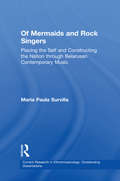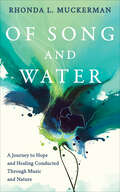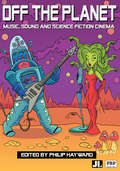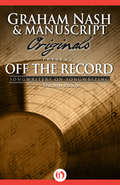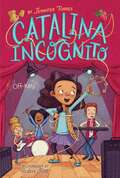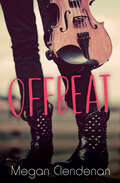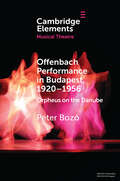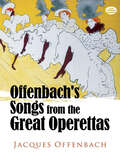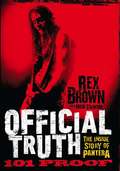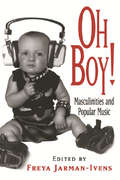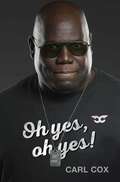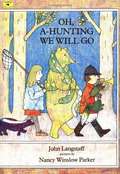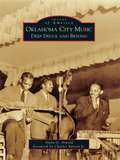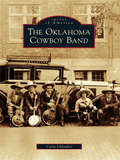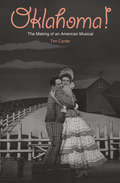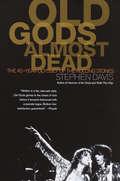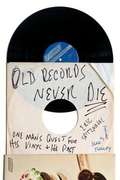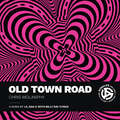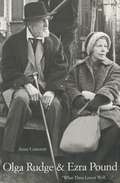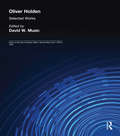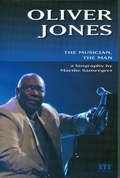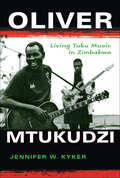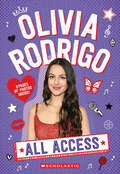- Table View
- List View
Of Mermaids and Rock Singers: Placing the Self and Constructing the Nation THrough Belarusan Contemporary Music (Current Research In Ethnomusicology: Outstanding Dissertations Ser. #2)
by Maria Paula SurvillaThis book examines the roles, functions, and interpretations of rock music as part of the initial push towards exploring national and personal identities in a newly independent Belarus. It also includes a summary of rock concert activity in Belarus.
Of Song and Water: A Journey to Hope and Healing Conducted Through Music and Nature
by Rhonda L MuckermanA musician, bereaved wife and mother&’s memoir of finding healing through music and the natural world while facing family illness and the loss of her child. Of Song and Water is a journey along the currents of music, nature, and healing which form the basis of life. Follow the life of musician, conductor and dreamer, Rhonda Levine Muckerman, as she and her family face the challenges of addiction, loss, and illness. After the death of their son Eliot, followed by her husband's diagnosis of Parkinson's disease, Rhonda makes an inner journey from her early formation as a professional conductor, through a landscape of dreams, intuition and waterways to find ultimate healing for herself and her family. Of Song and Water is a story for anyone who wants to discover a path to healing within, accompanied by the song and water of life.
Off the Planet: Music, Sound and Science Fiction Cinema (Encounters)
by Philip HaywardOver the last decade, music and sound have been increasingly recognized as an important—if often neglected—aspect of film production and film studies. Off the Planet comprises a lively, stimulating, and diverse collection of essays on aspects of music, sound, and Science Fiction cinema. Following a detailed historical introduction to the development of sound and music in the genre, individual chapters analyze key films, film series, composers, and directors in the postwar era. The first part of the anthology profiles seminal 1950s productions such as The Day the Earth Stood Still, the first Godzilla film, and Forbidden Planet. Later chapters analyze the work of composer John Williams, the career of director David Cronenberg, the Mad Max series, James Cameron’s Terminators, and other notable SF films such as Space Is the Place, Blade Runner, Mars Attacks!, and The Matrix. Off the Planet is an important contribution to the emerging body of work in music and film. Contributors include leading film experts from Australia, Canada, Japan, New Zealand, the United Kingdom, and the United States.Distributed for John Libbey Publishing
Off the Record
by Graham Nash Manuscript OriginalsCan you remember exactly where you were the first time you heard "What a Wonderful World" and how it made you feel? Did you play Paul Williams's "We've Only Just Begun" at your wedding? Throughout time, certain songs and their lyrics have come to act as key emotional landmarks in our hearts and minds and continue to resonate throughout our lives. Graham Nash and Manuscript Originals present Off the Record, a premier collection of twenty-five of the most talented and successful songwriters of all time. These writers share their thoughts and memories about the creation of their classic songs, how they fell in love with music, their careers in the music business, and the art of songwriting in over two hundred beautifully designed pages of personal interviews illuminated with historical archival photographs of each artist and the first performers or groups to record the songs. In addition, each songwriter has personally created an original handwritten manuscript of the lyrics to his or her featured song, which is artfully displayed in that songwriter's chapter.Among the songwriters and songs included in Off the Record are Graham Nash on "Our House," Carole King on "I Feel the Earth Move," John Lee Hooker on "Boom Boom," Grace Slick on "White Rabbit," Ben E. King on "Stand by Me", Mac Davis on "In the Ghetto," Paul Williams on "We've Only Just Begun," Peter Yarrow on "Puff, the Magic Dragon," George David Weiss on "What a Wonderful World," Ervin Drake on "It Was a Very Good Year," Jimmie Davis on "You Are My Sunshine," and many more.Off the Record is a celebration of the art of songwriting, these twenty-five classic songs, and the lives and talents of their remarkable writers. We hope you will enjoy this musical journey through some of the most beloved songs of our times, which have impacted the lives of people throughout the world.
Off-Key (Catalina Incognito #3)
by Jennifer TorresOne Day at a Time meets Mindy Kim in this third book in a charming new chapter book series about Catalina Castaneda, a Mexican American girl with a magical sewing kit who wants to start a band.Catalina can&’t wait for the upcoming school talent show! Along with some of her classmates, they decide to rock out and form a band for the big day. But Catalina has some...specific ideas on how the band should look and sound. Can Catalina learn to be part of the band, or will she find herself working on a solo act?
Offbeat (Orca Limelights)
by Megan ClendenanFourteen-year-old Rose is sure she's going to become a folk-music sensation, with her best friend, Shilo, at her side. But first Rose needs to convince her mom to keep paying for her expensive violin lessons. Her mom wants her to join the youth symphony and focus on classical music, in preparation for a music degree at university. When Rose enters a fiddle competition with a unique prize for the winner, she hopes to show her mom she can really can make it as a folk musician. This short novel is a high-interest, low-reading level book for middle-grade readers who are building reading skills, want a quick read or say they don’t like to read!
Offenbach Performance in Budapest, 1920–1956: Orpheus on the Danube (Elements in Musical Theatre)
by Péter BozóAs a legacy of the Habsburg Empire, performances of Jacques Offenbach's musical stage works played an important role in Budapest musico-theatrical life in the twentieth century. However, between the collapse of the Empire and the 1956 anti-Soviet revolution, political ideologies strongly influenced the character of these productions, when they took place. Public performances of Offenbach's works were prohibited between 1938 and 1945 and they became the bases for propagandadistic adaptations in the 1950s. This element explores how the local operetta tradition and the vogue of operettas featuring composers as characters during the interwar period were also important factors in how Offenbach's stage works were performed in mid-twentieth century Budapest in versions that sometimes bore little resemblance to the originals.
Offenbach's Songs from the Great Operettas (Dover Opera Scores)
by Jacques OffenbachJacques Offenbach (1819-80) ranks among the greatest composers of lighthearted operettas, and his famous songs continue to charm millions who know neither their names nor their composer. This volume features the sheet music for 38 popular songs from 14 operettas. All are reproduced from the original sheet music -- a few from the original piano-vocal scores, and some with lively pictorial covers. Contents include four songs from Orpheé aux enfers (Orpheus in the Underworld), five songs from La belle Hélène, four songs from La vie parisienne, six songs from La Grande Duchesse de Gérolstein, seven songs from La Périchole, three songs from La fille du tambour-major, and more. The complete French texts appear on the music pages, and a separate section offers English translations. All songs were chosen by Antonio de Almeida, a renowned conductor and authority on Offenbach, who also provides an informative Introduction.
Official Truth, 101 Proof: The Inside Story of Pantera
by Rex BrownFew heavy metal acts survived the turmoil of the early 1990s music scene. Pantera was different. Instead of humoring the market, the band instead demanded that the audience come to them by releasing a series of fiercely uncompromising, platinum albums, including Vulgar Display of Power and Far Beyond Driven-two #1 albums that, like Metallica's And Justice for All, sold millions of copies despite minimal airplay.Rex Brown's memoir is the definitive account of life inside one of rock's biggest bands, which succeeded against all odds but ultimately ended in tragedy when iconic lead guitarist Darrell "Dimebag" Abbott was murdered mid-performance by a deranged fan.This is a lucid account of the previously untold story behind one of the most influential bands in heavy metal history, written by the man best qualified to tell the truth about those incredible and often difficult years of fame and excess.
Oh Boy!: Masculinities and Popular Music
by Freya Jarman-IvensFrom Muddy Waters to Mick Jagger, Elvis to Freddie Mercury, Jeff Buckley to Justin Timberlake, masculinity in popular music has been an issue explored by performers, critics, and audiences. From the dominance of the blues singer over his "woman" to the sensitive singer/songwriter, popular music artists have adopted various gendered personae in a search for new forms of expression. Sometimes these roles shift as the singer ages, attitudes change, or new challenges on the pop scene arise; other times, the persona hardens into a shell-like mask that the performer struggles to escape. Oh Boy! Masculinities and Popular Music is the first serious study of how forms of masculinity are negotiated, constructed, represented and addressed across a range of popular music texts and practices. Written by a group of internationally recognized popular music scholars—including Sheila Whiteley, Richard Middleton, and Judith Halberstam—these essays study the concept of masculinity in performance and appearance, and how both male and female artists have engaged with notions of masculinity in popular music.
Oh yes, oh yes!
by Carl CoxFrom warm up DJ at the birth of Acid House to global main stage headline artist today, Carl Cox continues to inspire and influence audiences and artists. Carl has been everything from a recording artist and producer to label owner, radio DJ and broadcaster. He is still all these things and much more with his star shining brighter than ever. Oh yes, oh yes! tells the story, in his own words, of the man known as 'The Three Deck Wizard' on the rave scene before evolving into 'The People's Choice' and the King of Ibiza; a DJ and artist who remains at the very top of his game and continues to innovate and thrill music-lovers on the world's biggest stages.Starting off as a shelf-stacker, grass cutter and scaffolder in the south London suburbs, Carl's phenomenal talents as a DJ grew out of a love of music nurtured in his parents' front room. In Oh yes, oh yes! he takes us to the heart of the party, from the UK rave scene to Burning Man and from Ibiza to Melbourne, and a career that in in many ways is the story of club culture and an inspiration to all those who choose to follow their dreams turning him into a living legend along the way. Oh yes, oh yes! is a remarkably candid and intimate portrait of an artist who has never lost touch with the people who share the dancefloor with him.'Carl is one of the few true pioneers of UK club culture internationally. He has opened the door to so many DJs and inspired so many, including me.' Gilles Peterson'Carl Cox wrote the script of what it means to be a DJ.' David Guetta'People use the term legend far too easily for my liking but Carl is legend personified.' Grooverider'Carl has always been my favourite. He is the complete DJ, also the DJs DJ. Records come to life when he plays them, rooms come to life when he rocks them. His enthusiasm is infectious, his commitment complete.' Norman Cook aka Fatboy Slim
Oh yes, oh yes!
by Carl CoxFrom warm up DJ at the birth of Acid House to global main stage headline artist today, Carl Cox continues to inspire and influence audiences and artists. Carl has been everything from a recording artist and producer to label owner, radio DJ and broadcaster. He is still all these things and much more with his star shining brighter than ever. Oh yes, oh yes! tells the story, in his own words, of the man known as 'The Three Deck Wizard' on the rave scene before evolving into 'The People's Choice' and the King of Ibiza; a DJ and artist who remains at the very top of his game and continues to innovate and thrill music-lovers on the world's biggest stages.Starting off as a shelf-stacker, grass cutter and scaffolder in the south London suburbs, Carl's phenomenal talents as a DJ grew out of a love of music nurtured in his parents' front room. In Oh yes, oh yes! he takes us to the heart of the party, from the UK rave scene to Burning Man and from Ibiza to Melbourne, and a career that in many ways is the story of club culture and an inspiration to all those who choose to follow their dreams turning him into a living legend along the way. Oh yes, oh yes! is a remarkably candid and intimate portrait of an artist who has never lost touch with the people who share the dancefloor with him.'Carl is one of the few true pioneers of UK club culture internationally. He has opened the door to so many DJs and inspired so many, including me.' Gilles Peterson'Carl Cox wrote the script of what it means to be a DJ.' David Guetta'People use the term legend far too easily for my liking but Carl is legend personified.' Grooverider'Carl has always been my favourite. He is the complete DJ, also the DJs DJ. Records come to life when he plays them, rooms come to life when he rocks them. His enthusiasm is infectious, his commitment complete.' Norman Cook aka Fatboy Slim
Oh, A-Hunting We Will Go (Fountas & Pinnell LLI Blue #Level E)
by John Langstaff Nancy ParkerOld and new verses for a popular folk song about hunting and capturing an animal--and then letting him go.
Oklahoma City Music: Deep Deuce and Beyond (Images of America)
by Charles Burton Jr. Anita G. ArnoldOklahoma City's rich music history traces back to Deep Deuce, the heart of the African American community that became an important resource for national jazz and blues bands seeking talented musicians who were often classically trained. Two icons and many legends are among the famous sons and daughters who lived in this cultural Mecca. Oklahoma City's Music: Deep Deuce and Beyond details the birth and growth of music in Oklahoma City's African American community from the 1920s until the late 1990s. Musical influences of families and individuals, venues, dance, and fashion blend with new-era traditions such as parades, jam sessions, and street parties to create a culture that became well known. This book explores how the seeds of music so deeply planted in the early days continue to produce great musicians and how the influences of those icons will vibrate throughout future international generations.
Oklahoma Cowboy Band, The (Images of America)
by Carla ChlouberThe Oklahoma Cowboy Band was the first western string band in the nation to broadcast over the radio and appear on vaudeville, drawing large audiences throughout the Midwest and Northeast. The band began in Ripley as Billy McGinty's Cowboy Band and first played over radio station KFRU in Bristow in May 1925. Billy McGinty was a Rough Rider with Theodore Roosevelt and performed in Buffalo Bill's Wild West Show. The public responded to the broadcast of his band with a steady stream of telegrams, telephone calls, and letters asking for more of that old-time cowboy music. Soon Otto Gray and his wife, Mommie, of Stillwater joined the band, with both performing rope tricks, Mommie singing sad songs, and their son, Owen, performing comedy routines as "the Uke Buster." Renamed Otto Gray and His Oklahoma Cowboys, the band traveled for a decade to such cities as St. Louis, Chicago, Cincinnati, Indianapolis, Pittsburgh, and Syracuse. Its custom-built Cadillacs drew crowds wherever the band went. By the early 1930s, other acts were copying the band's cowboy themes and songs, and Otto Gray's lawyers threatened legal action. The lawyers met with only limited success, though, and today the cowboy image is firmly established in country music, thanks in large part to the early success of Billy McGinty, Otto Gray, and the Oklahoma Cowboy Band.
Oklahoma!: The Making of an American Musical (Broadway Legacies Ser.)
by Tim CarterThe backstage story of the timeless Broadway hit, and how Rodgers and Hammerstein brought it to life: &“Meticulously researched&” (Publishers Weekly). Oklahoma! premiered on Broadway in 1943 under the auspices of the Theatre Guild, and today it is performed more frequently than any other Rodgers and Hammerstein musical. In this book, Tim Carter offers the first fully documented history of the making of this celebrated American musical. Drawing on research from rare theater archives, manuscripts, journalism, and other sources, Carter records every step in the development of Oklahoma! The book is filled with rich and fascinating details about how Rodgers and Hammerstein first came together, the casting process, how Agnes de Mille became the show&’s choreographer, and the drafts and revisions that ultimately gave the musical its final shape. Carter also shows the lofty aspirations of both the creators and producers and the mythmaking that surrounded Oklahoma! from its very inception, and demonstrates just what made it part of its times.
Old Gods Almost Dead: The 40-year Odyssey of the Rolling Stones
by Stephen DavisThe acclaimed, bestselling rock-and-roll biographer delivers the first complete, unexpurgated history of the world's greatest band. The saga of the Rolling Stones is the central epic in rock mythology. From their debut as the intermission band at London's Marquee Club in 1962 through their latest record-setting Bridges to Babylon world tour, the Rolling Stones have defined a musical genre and experienced godlike adulation, quarrels, addiction, legal traumas, and descents into madness and death_while steadfastly refusing to fade away. Now Stephen Davis, the New York Times bestselling author of Hammer of the Gods and Walk This Way, who has followed the Stones for three decades, presents their whole story, replete with vivid details of the Stones' musical successes and personal excesses. Born into the wartime England of air-raid sirens, bombing raids, and strict rationing, the Rolling Stones came of age in the 1950s, as American blues and pop arrived in Europe. Among London's most ardent blues fans in the early 1960s was a short blond teenage guitar player named Brian Jones, who hooked up with a lorry driver's only son, Charlie Watts, a jazz drummer. At the same time, popular and studious Michael Philip Jagger--who, as a boy, bawled out a phonetic version of "La Bamba" with an eye-popping intensity that scared his parents--began sharing blues records with a primary school classmate, Keith "Ricky" Richards, a shy underachiever, whose idol was Chuck Berry. In 1962 the four young men, joined by Bill Perks (later Wyman) on bass, formed a band rhythm and blues band, which Brian Jones named the "the Rollin' Stones" in honor of the Muddy Waters blues classic. Using the biography of the Rolling Stones as a narrative spine, Old God Almost Dead builds a new, multi-layered version of the Stones' story, locating the band beyond the musical world they dominated and showing how they influenced, and were influenced by, the other artistic movements of their era: the blues revival, Swinging London, the Beats, Bob Dylan's Stones-inspired shift from protest to pop, Pop Art and Andy Warhol's New York, the "Underground" politics of the 1960s, Moroccan energy and European orientalism, Jamaican reggae, the Glam and Punk subcultures, and the technologic advances of the video and digital revolution. At the same time, Old Gods Almost Dead documents the intense backstage lives of the Stones: the feuds, the drugs, the marriages, and the affairs that inspired and informed their songs; and the business of making records and putting on shows. The first new biography of the Rolling Stones since the early 1980s, Old Gods Almost Dead is the most comprehensive book to date, and one of the few to cover all the band's members. It is a celebration of the Rolling Stones as an often courageous, often foolish gang of artists who not only showed us new worlds, but new ways of living in them. It is a saga as raunchily, vibrantly entertaining as the Stones themselves.
Old MacDonald Had a Farm
by Ben MahanA classic children's song favorite brought to life. Picture descriptions are added.
Old Records Never Die: One Man's Quest for His Vinyl and His Past
by Eric Spitznagel Jeff TweedyForeword by Wilco's Jeff Tweedy"Memories are far more indelible when married to the physical world, and Spitznagel proves the point in this vivid book. We love vinyl records because they combine the tactile, the visual, the seeable effects of age and care and carelessless. When he searches for the records he lost and sold, Spitznagel is trying to return to a tangible past, and he details that process with great sensitivity and impact."--Dave Eggers, author of The CircleHigh Fidelity meets Killing Yourself to Live in this memoir of one man's search for his lost record collection. As he finds himself within spitting distance of middle-age, journalist Eric Spitznagel feels acutely the loss of...something. Freedom? Maybe. Coolness? Could be. The records he sold in a financial pinch? Definitely. To find out for sure, he sets out on a quest to find the original vinyl artifacts from his past. Not just copies. The exact same records: The Bon Jovi record with his first girlfriend's phone number scrawled on the front sleeve. The KISS Alive II he once shared with his little brother. The Replacements Let It Be he's pretty sure, 20 years later, would still smell like weed. As he embarks on his hero's journey, he reminisces about the actual records, the music, and the people he listened to it with--old girlfriends, his high school pals, and, most poignantly, his father and his young son. He explores the magic of music and memory as he interweaves his adventures in record- culture with questions about our connection to our past, whether we can ever recapture it, and whether we would want to if we could.From the Trade Paperback edition.
Old Town Road (Singles)
by Chris MolanphyIn Old Town Road, Chris Molanphy considers Lil Nas X’s debut single as pop artifact, chart phenomenon, and cultural watershed. “Old Town Road” was more than a massive hit, with the most weeks at No. 1 in Billboard Hot 100 history. It is also a prism through which to track the evolution of popular music consumption and the ways race influences how the music industry categorizes songs and artists. By both lionizing and satirizing genre tropes—it’s a country song built from an alternative rock sample, a hip-hop song in which nobody raps, a comical song that transcends novelty, and a queer anthem—Lil Nas X troubles the very idea of genre. Ultimately, Molanphy shows how “Old Town Road” channeled decades of Americana to point the way toward our cultural future.
Olga Rudge and Ezra Pound: What Thou Lovest Well ...
by Anne ConoverA loving and admiring companion for half a century to literary titan Ezra Pound, concert violinist Olga Rudge was the muse who inspired the poet to complete his epic poem,The Cantos,and the mother of his only daughter, Mary. Strong-minded and defiant of conventions, Rudge knew the best and worst of times with Pound. With him, she coped with the wrenching dislocations brought about by two catastrophic world wars and experienced modernism's radical transformation of the arts. In this enlightening biography, Anne Conover offers a full portrait of Olga Rudge (1895-1996), drawing for the first time on Rudge's extensive unpublished personal notebooks and correspondence. Conover explores Rudge's relationship with Pound, her influence on his life and career, and her perspective on many details of his controversial life, as well as her own musical career as a violinist and musicologist and a key figure in the revival of Vivaldi's music in the 1930s. In addition to mining documentary sources, the author interviewed Rudge and family members and friends. The result is a vivid account of a highly intelligent and talented woman and the controversial poet whose flame she tended to the end of her long life. The book quotes extensively from the Rudge-Pound letters--an almost daily correspondence that began in the 1920s and continued until Pound's death in 1972. These letters shed light on many aspects of Pound's disturbing personality; the complicated and delicate balance he maintained between the two most significant women in his life, Olga and his wife Dorothy, for fifty years; the birth of Olga and Ezra's daughter Mary de Rachewiltz; Pound's alleged anti-Semitism and Fascist sympathies; his wartime broadcasts over Rome radio and indictment for treason; and his twelve-year incarceration in St. Elizabeth's Hospital for the mentally ill.
Oliver Holden: Selected Works (Music of the New American Nation: Sacred Music from 1780 to 1820)
by David W. MusicFirst Published in 1998. Routledge is an imprint of Taylor & Francis, an informa company.
Oliver Jones
by Marthe SansregretBorn in Montreal, Oliver Jones performed his first piano concert at five years old. He has become one of the most celebrated representatives of the Montreal Jazz Festival and a worldwide musical ambassador for Canada on many international tours. This exclusive authorized biography begins with his roots the enslavement of his African ancestors and immigration of his parents to Canada from Barbados and takes us to the present. Oliver Jones has received many awards to recognize his achievements, both as a musician and as a human being: the Martin Luther King Award, a Juno Award, the Cool Jazz Award of the Izzy Asper Foundation, the Order of Canada, the Order of Quebec, the Oscar Peterson Award, the Governor Generals Performing Arts Award, and in 2006, two National Jazz Awards: Best Jazz Keyboard of the Year and Best CD with Ranee Lee for their album Just You, Just Me
Oliver Mtukudzi: Living Tuku Music in Zimbabwe (African Expressive Cultures)
by Jennifer W. KykerOliver "Tuku" Mtukudzi, a Zimbabwean guitarist, vocalist, and composer, has performed worldwide and released some 50 albums. One of a handful of artists to have a beat named after him, Mtukudzi blends Zimbabwean traditional sounds with South African township music and American gospel and soul, to compose what is known as Tuku Music. In this biography, Jennifer W. Kyker looks at Mtukudzi's life and art, from his encounters with Rhodesian soldiers during the Zimbabwe war of liberation to his friendship with American blues artist Bonnie Raitt. With unprecedented access to Mtukudzi, Kyker breaks down his distinctive performance style using the Shona concept of "hunhu," or human identity through moral relationships, as a framework. By reading Mtukudzi's life in connection with his lyrics and the social milieu in which they were created, Kyker offers an engaging portrait of one of African music's most recognized performers. Interviews with family, friends, and band members make this a penetrating, sensitive, and uplifting biography of one of the world's most popular musicians.
Olivia Rodrigo: All Access
by Emma Carlson BerneAre you obsessed with Olivia Rodrigo or is she just a stranger?Get to know the real Olivia Rodrigo in this biography that's packed with fun facts, stats, top tens, listicles, and lots more! Grab your driver's license and follow Olivia's journey from High School Musical: The Musical: The Series to GUTS and beyond!It's all inside this book — Olivia's teenage dreams, her embarassing love stories, her grudges, her gut-spilling, and her friends and fans. Plus, you'll be obsessed with discovering Olivia's faves — sour foods, lyrics, fellow musicians, and much more!With eight pages of full-color photos, this book is good 4 u!
